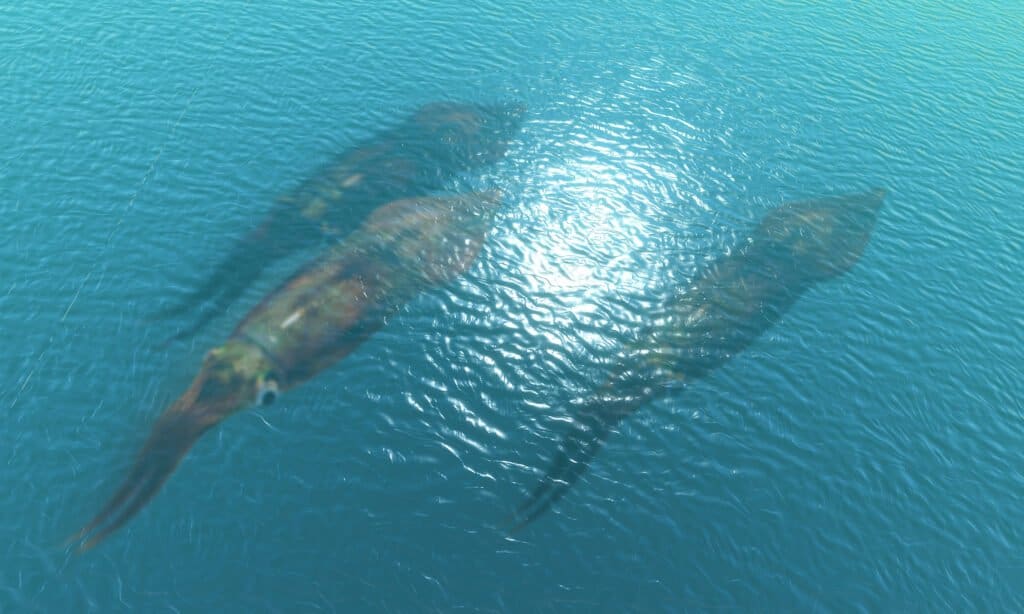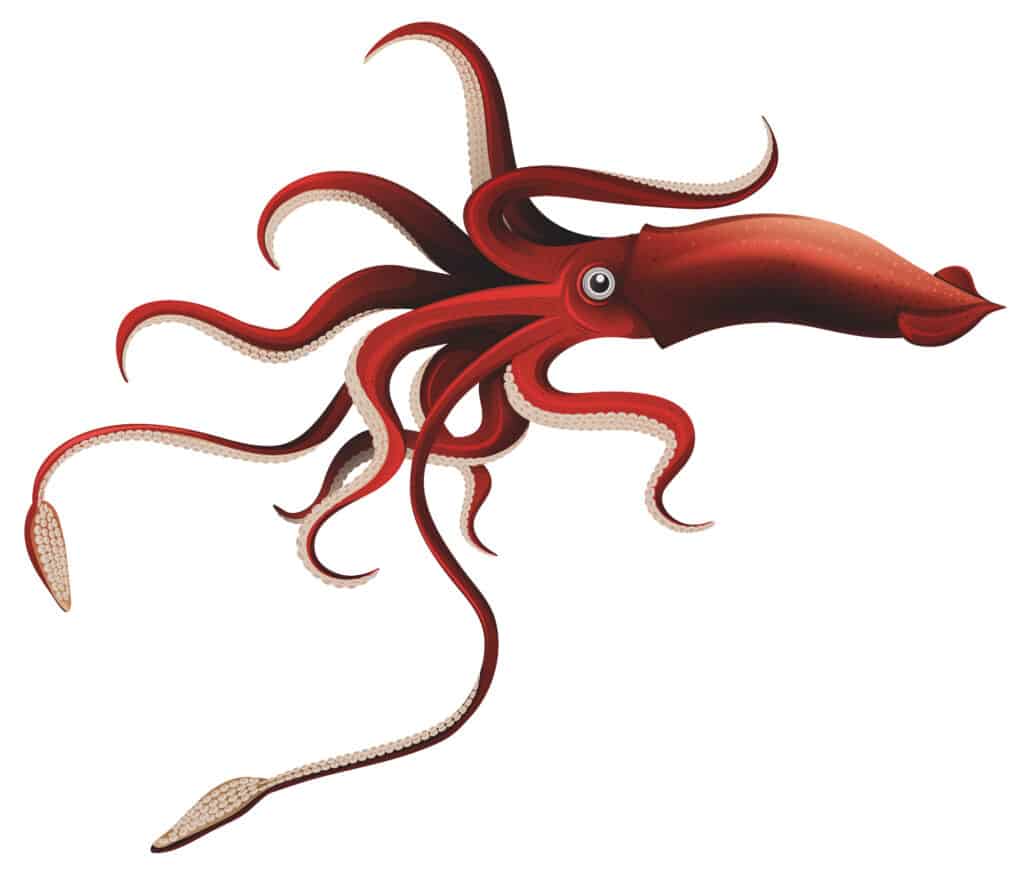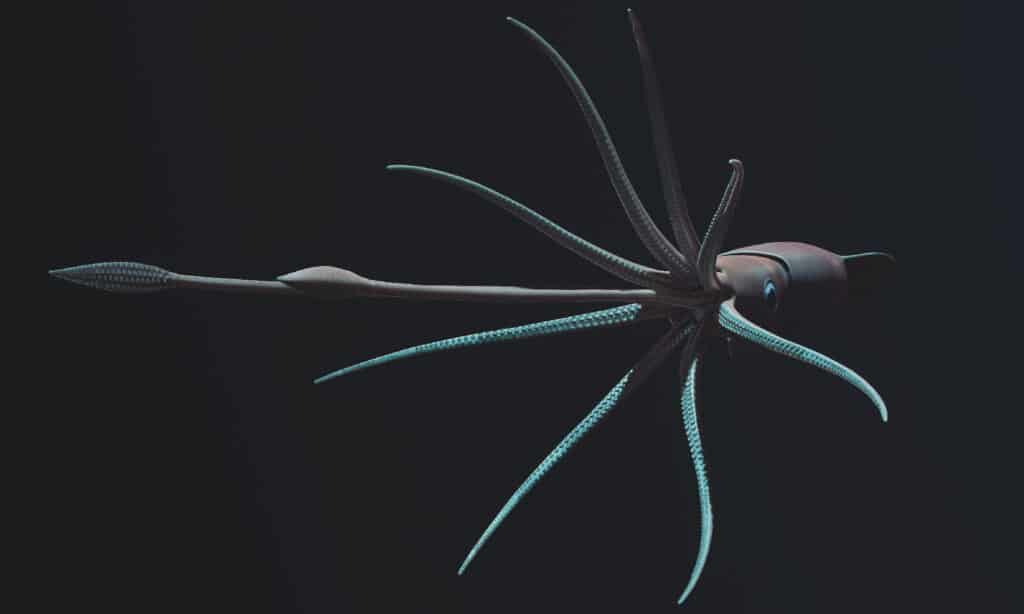Who doesn’t love a bit of calamari? Humans have been eating squid for quite some time, but if we were around a few million years ago, things might have been reversed. In fact, one squid was so large that it probably could have killed humans without too much difficulty. What is reverse calamari? This squid might have known!
Meet Tusoteuthis, a Giant Squid From the Cretaceous Period

©Jiri Flogel/Shutterstock.com
Tusoteuthis was an ancient squid that likely grew between 25 to 35 feet long and lived millions of years ago.
There are many different species of squid alive today, but these creatures have been around for quite some time! In fact, one squid that lived millions of years ago could be a contender for the largest squid to have ever lived. Meet Tusoteuthis. Tusoteuthis was a genus of cephalopods that have since gone extinct but left their mark on the deep oceans of old.
Although Tusoteuthis is classified as a genus related to squid, further research has shown that they may actually be closer related to octopus. Regardless, the creatures would have appeared more similar to modern-day squid, especially the giant squid.
Tusoteuthis is a genus, meaning it’s a group of squid and not a single species. The primary species associated with this overarching group is Tusotheuthis Longa. The genus name, Tusoteuthis, directly translates to “crushed squid”. The name comes from the common occurrence of the pen (essentially the spine of the squid) being crushed during the fossilization process. This delicate chitinous structure is almost always discovered to be crushed after being preserved for millions of years.
What Did Tusoteuthis Look Like?

©iStock.com/blueringmedia
Squid and other cephalopods have looked quite similar over their history, and natural selection seems to have made them extremely resilient to change, likely due to their success.
Tusoteuthis grew to around 35 feet long and had ten tentacles with suckers on each one. Additionally, Tusoteuthis wouldn’t have had a shell and would have instead had an elongated body with a rigid interior known as a pen (or gladius). This pen is similar to a backbone in other creatures, but it would have been made of chitin instead of true bone.
Like modern squid and octopus, Tusoteuthis would have also had large eyes and a sharp beak. Altogether, the advanced vision, sharp beak, and strong tentacles would have made this deep-sea nightmare a formidable predator for most creatures entering its domain.
How Long Ago Did Tusoteuthis Live?
Tusoteuthis was a prehistoric genus of squid that lived during the Cretaceous period. More specifically, Tusoteuthis would have lived between the Santonian and Campanian ages, the fourth and fifth stages of the six total during the Cretaceous.
The Cretaceous began around 145 million years ago and ended 66 million years ago. The end of the Cretaceous was brought about by the massive asteroid striking the earth, ending the reign of the dinosaurs. Tusoteuthis lived just before the end of this lone geological era.
What Did Tusoteuthis Eat?

©iStock.com/3dsam79
Tusoteuthis was an extremely large cephalopod that had a few distinct tools it used to hunt. Its primary source of food was probably other cephalopods, fish, and anything else that it could get its tentacles on. In fact, the diet of Tusoteuthis would have been extremely similar to that of the giant squids today. Giant squids are roughly the same size as Tusoteuthis and hold a similar role in the food chain.
That being said, Tusoteuthis was also prey for other creatures. The oceans during the Cretaceous period were extremely dangerous, especially for a soft-bodied squid-like creature. Common predators of Tusoteuthis were likely larger predatory fish, as well as large reptiles like the Mosasaurus. In fact, one fossil of Cimolichthys nepaholica was discovered that depicted it eating Tusoteuthis. In the incredibly preserved scene, Cimolichthys nepaholica had eaten half of Tusoteuthis, but Tusoteuthis didn’t go down without a fight. Tusoteuthis had reached its tentacles outside of the predator’s mouth and grabbed onto its gills. Ultimately, they both died as Cimolichthys nepaholica suffocated with Tusoteuthis stuck halfway swallowed.
Up Next
- Ancient Oddities: 8 Extinct Sea Creatures
- Discover the 23-Foot, Gigantic Ancient Crocodile With Fins
- This Huge Ancient Crocodile Would Have Towered Over Humans
The photo featured at the top of this post is © mikeledray/Shutterstock.com
Thank you for reading! Have some feedback for us? Contact the AZ Animals editorial team.






